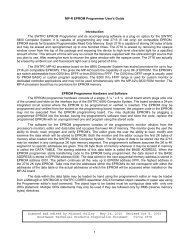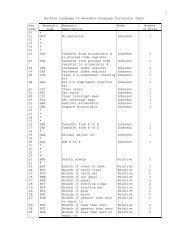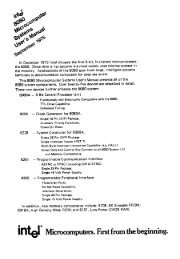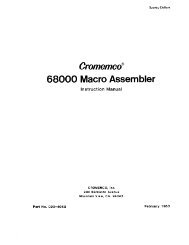The System Manual of SOL-20 - History of Computers
The System Manual of SOL-20 - History of Computers
The System Manual of SOL-20 - History of Computers
Create successful ePaper yourself
Turn your PDF publications into a flip-book with our unique Google optimized e-Paper software.
PROCESSOR TECHNOLOGY CORPORATION<br />
Sol THEORY OF OPERATION<br />
SECTION VIII<br />
put pin 5 goes low to clear the first stage. <strong>The</strong> high on output pin<br />
6 is inverted by NAND gate UIO to supply a low active !STROBE on pin 3<br />
<strong>of</strong> J1. (Note that J1 on the keyboard connects to J3 on the Sol-PC.)<br />
<strong>The</strong> next inverted 6 usec clock resets the second U11 stage. We thus<br />
have a 6 usec strobe pulse following the latching <strong>of</strong> data into U1 and<br />
U2.<br />
<strong>The</strong> complement <strong>of</strong> KEY_minus_1 on output pin 8 <strong>of</strong> U26 is fed<br />
to input pin 10 <strong>of</strong> NAND gate U16 and is translated to a high on pin<br />
8. <strong>The</strong> other input on pin 9 is high at this time since it is driven<br />
by the signal which indicates the third count cycle. A three-input<br />
NAND gate, U27, thus has a high on pin 2. A second input on pin 1 is<br />
KEY which is active (high) from the first count cycle <strong>of</strong> the key closure.<br />
<strong>The</strong> remaining input on pin 13 is supplied by pin 11 <strong>of</strong> U16,<br />
and it is low only when the repeat function is operating. U27 is<br />
consequently satisfied and outputs a low on pin 12.<br />
This low appears at pin 5 <strong>of</strong> NOR gate U16. Pin 4 <strong>of</strong> U5 is<br />
high at this point by virtue <strong>of</strong> a low on pin 1 <strong>of</strong> U16 which indicates<br />
the third count. Thus, the high on pin 6 <strong>of</strong> U16 will be stored in<br />
the second bit location U<strong>20</strong> when !φ2 goes low at pin <strong>20</strong> <strong>of</strong> U<strong>20</strong>. When<br />
this happens D02 (pin 12) <strong>of</strong> U<strong>20</strong> goes high to indicate the new status<br />
<strong>of</strong> this bit.<br />
<strong>The</strong> D02 output is inverted in U10 and applied to input pin 2<br />
<strong>of</strong> another U26 D flip-flop and to the Capacitance Keyswitch Detector<br />
as PKD. PKD serves to lower the detector threshold; that is, the detector<br />
<strong>of</strong>fers less "resistance" to its input. This is positive feedback<br />
that allows the detector to discriminate between noise and a key<br />
closure. Note that two key closures are required before the detector<br />
threshold is lowered.<br />
<strong>The</strong> inverted D02 output from U<strong>20</strong> also appears at the D input<br />
(pin 2) <strong>of</strong> U26. Since this flip flop is clocked by !φ1, the prior<br />
status <strong>of</strong> !PKD, called "!PKD_minus_1", is already present in this latch<br />
on output pin 5. If we are on the second count cycle <strong>of</strong> a key closure,<br />
pin 5 is high. If we are on the third count or more, it is low<br />
to inhibit U25. As previously mentioned, !PKD_minus_1 is also connected<br />
to the NOR gate (U16) used to feed data to pin 11 <strong>of</strong> U<strong>20</strong> from<br />
KEY_minus_1.<br />
When the current KEY signal is released, pin 12 <strong>of</strong> NAND gate<br />
U27 and pin 5 <strong>of</strong> NAND gate U16 go high. <strong>The</strong> U16 NAND gate that inputs<br />
to pin 4 <strong>of</strong> U16 looks at KEY_minus_1 on pin 2 and the complement<br />
<strong>of</strong> !PKD_minus_1 on pin 1. Thus, pin 1 is high for the first one<br />
and a half counts and pin 2 is high for the first count. Upon release<br />
<strong>of</strong> KEY, therefore, pin 3 <strong>of</strong> U16 is low for the first count.<br />
On the second count, KEY_minus_I goes low--as do pin 6 <strong>of</strong> U16 and<br />
pin 12 <strong>of</strong> U<strong>20</strong>. On the next !φ2 clock, the data is read into U<strong>20</strong>. <strong>The</strong><br />
output on pin 12 <strong>of</strong> U<strong>20</strong> changes to remove !PKD which increases the<br />
Capacitance Keyswitch Detector threshold for greater noise immunity.<br />
It also sets !PKD_minus_1 on pin 5 <strong>of</strong> U26 on the third count cycle<br />
VIII-43












